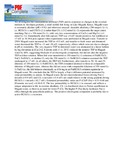| dc.description.abstract | We investigated the transepithelial potential (TEP) and its responses to changes in the external medium in Alcolapia grahami, a small cichlid fish living in Lake Magadi, Kenya. Magadi water is extremely alkaline (pH = 9.92) and otherwise unusual: titratable alkalinity (290 mequiv L(-1), i.e. HCO(3) (-) and CO(3) (2-)) rather than Cl(-) (112 mmol L(-1)) represents the major anion matching Na(+) = 356 mmol L(-1), with very low concentrations of Ca(2+) and Mg(2+) (<1 mmol L(-1)). Immediately after fish capture, TEP was +4 mV (inside positive), but stabilized at +7 mV at 10-30 h post-capture when experiments were performed in Magadi water. Transfer to 250% Magadi water increased the TEP to +9.5 mV, and transfer to fresh water and deionized water decreased the TEP to -13 and -28 mV, respectively, effects which were not due to changes in pH or osmolality. The very negative TEP in deionized water was attenuated in a linear fashion by log elevations in [Ca(2+)]. Extreme cold (1 vs. 28°C) reduced the positive TEP in Magadi water by 60%, suggesting blockade of an electrogenic component, but did not alter the negative TEP in dilute solution. When fish were transferred to 350 mmol L(-1) solutions of NaHCO(3), NaCl, NaNO(3), or choline Cl, only the 350 mmol L(-1) NaHCO(3) solution sustained the TEP unchanged at +7 mV; in all others, the TEP fell. Furthermore, after transfer to 50, 10, and 2% dilutions of 350 mmol L(-1) NaHCO(3), the TEPs remained identical to those in comparable dilutions of Magadi water, whereas this did not occur with comparable dilutions of 350 mmol L(-1) NaCl-i.e. the fish behaves electrically as if living in an NaHCO(3) solution equimolar to Magadi water. We conclude that the TEP is largely a Na(+) diffusion potential attenuated by some permeability to anions. In Magadi water, the net electrochemical forces driving Na(+) inwards (+9.9 mV) and Cl(-) outwards (+3.4 mV) are small relative to the strong gradient driving HCO(3) (-) inwards (-82.7 mV). Estimated permeability ratios are P (Cl)/P (Na) = 0.51-0.68 and [Formula: see text] = 0.10-0.33. The low permeability to HCO(3) (-) is unusual, and reflects a unique adaptation to life in extreme alkalinity. Cl(-) is distributed close to Nernst equilibrium in Magadi water, so there is no need for lower P (Cl). The higher P (Na) likely facilitates Na(+) efflux through the paracellular pathway. The positive electrogenic component is probably due to active HCO(3) (-) excretion. | en |

